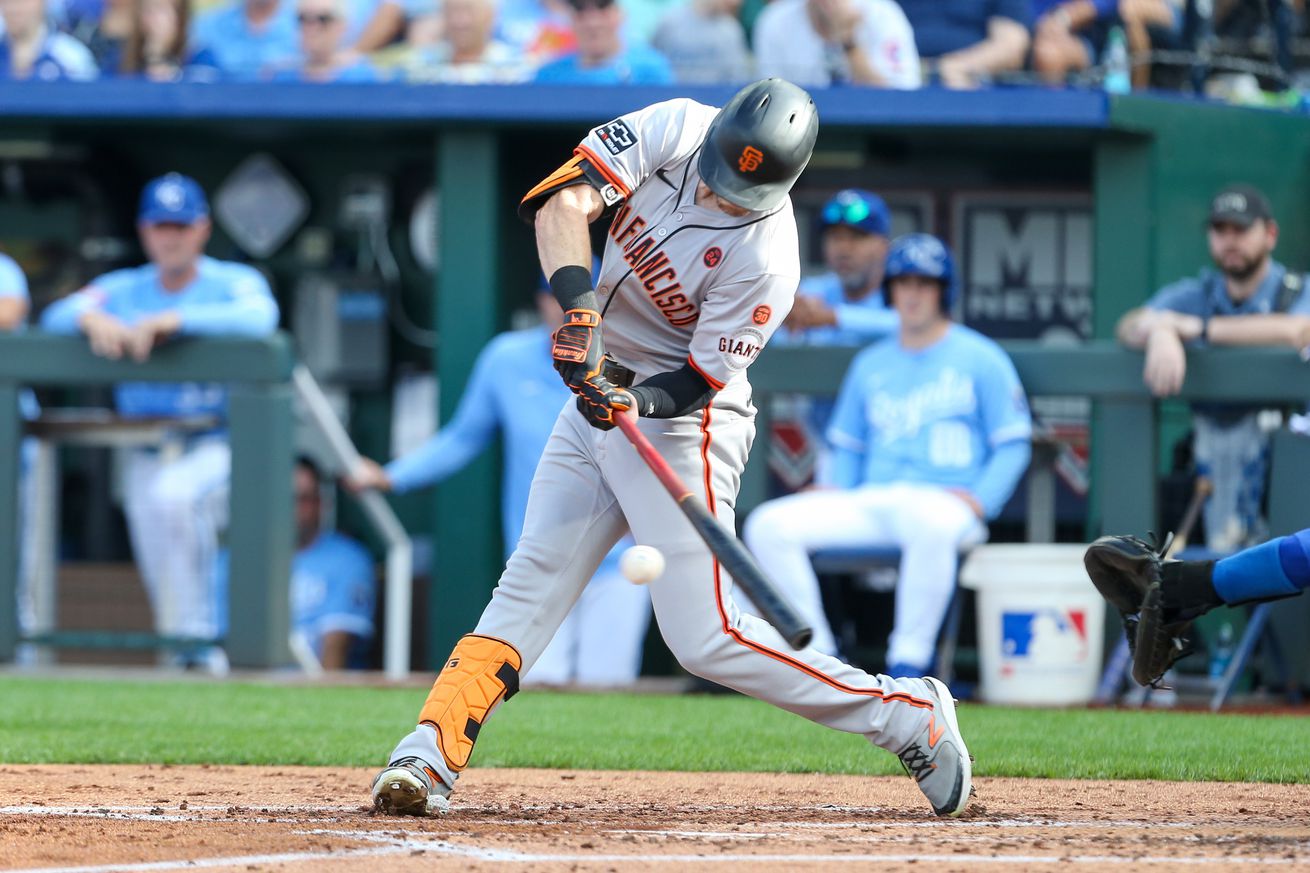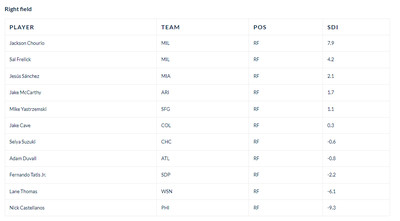
Baseball’s a tough business even for a solid player, but if there’s one thing Yaz can do it’s persevere.
The San Francisco Giants have an easy but sizable decision to make regarding fan favorite Mike Yastrzemski this offseason. To tender or not to tender, that is the question. Has he earned it?
With 3 home runs on the current road trip, Mike Yastrzemski has brought his season batting line (.232/.306/.443) up to within shouting distance of last season’s line (.233/.330/.445) and given himself a shot at a ~$10 million contract he appears to be in line for based on the history of MLB’s salary arbitration process. His contract for 2024 is $7.9 million.
A couple of weeks ago, after the Giants blew out the Brewers, Yaz told NBC Sports Bay Area’s Alex Pavlovic,
I love the group here, the staff, the front office has treated me like family and they’re amazing, the fans are incredible and made it feel like home. The goal is to stay here as long as I can and I understand that that’s usually based on performance, so I’m just trying to continue to bring value every day
He’s doing that by being solid in the leadoff role against right-handed starters and playing solid defense in the outfield. On that last point, it’s worth noting that while FanGraphs’ Defensive Runs Above Average and Statcast’s Outs Above Average valuations both tag him with negative numbers (-4.8 runs and -1 OAA, respectively), the SABR Defensive Index rating — a component of the Gold Glove Award formula — gives him a positive valuation of +1.1, 5th among qualified NL outfielders. Through August 11, 2024, the penultimate list before the Gold Glove Award is announced:

He’s led off a game 19 times and in those 19 PA he’s 6-for-15 with 3 home runs, a double, and 4 walks against just 1 strikeout. He’s done everything the team has asked him to do and done it solidly, but again: is it enough?
For the past three seasons, Mike Yastrzemski has basically been a 1.5-win player. When it comes to the number after the decimal point, it’s more logical to round up or down, so:
2022: 1.5 fWAR
2023: 1.6 fWAR
2024: 1.7 fWAR
It helps that offense has declined leaguewide, because his batting line actually puts him nicely above league average (109 wRC+), even as his OPS has dropped from .775 last year to .749 this year. He still hits the ball hard and that’s important. His cumulative .219 ISO since 2019 is 50th in the sport, slightly ahead of Matt Chapman and Manny Machado (both .217). Of course, factoring in all the numbers, he’s been half as valuable as both in terms of WAR.
At the end of the day, we need only to concern ourselves with what the Giants project from Yastrzemski and if that projection fits their needs. The key is figuring out the value he might provide next year in his age-34 season, and that’s where the analysis gets tricky. There’s also what they think of him as a person, but I’ll discuss that near the end.
On the one hand, Yastrzemski has been a solid enough player that a team like the Giants should probably go ahead with committing $10 million or so to keep him around one more year. There are injury concerns with any post-30s player, but Yaz in particular has had the injury bug follow him around his whole career. So, availability, decline, and surplus value are all key factors that inhibit an easy call.
In the aforementioned Pavlovic piece, he defines that $10 million salary figure like this:
Given that teams generally view one WAR to be worth right around that mark, Yastrzemski certainly would bring surplus value if he continues to repeat what he has done this season.
The dollar per WAR figure tends to fluctuate, depending on who you ask. Jerry Reinsdorf? The Tampa Bay Rays? A win above replacement costs about $5-$6 million. For most everyone else, it’s probably more like $8-$9 million. See this Tom Tango tweet from 2022 when we were all trying to figure out what Aaron Judge would get:
We can see how they are valuing Judge, if we look at 7 year extension starting in 2023, WAR of 4.8 per @DSzymborski. To get to 7/213.5, assume 7.5MM$/win in 2022, increasing by 0.5 per year, with WAR dropping by 0.5
If you start at 8.5MM$, dropping WAR by 0.6, you get same thing https://t.co/i2JaESP1Z4 pic.twitter.com/k8V7yaqN1n
— Tangotiger (@tangotiger) April 9, 2022
So, at the very least, it isn’t static (again, unless you’re the Rays or Jerry Reinsdorf), but given years of free agent contract predictions, there also seems to be a catch or a wrinkle we often don’t consider.
There’s a different calculation for the first win above replacement. Take a look at recent contracts handed out to players who are basically 4-win guys. Let’s use Matt Chapman’s extension as an example.
I’m going to guess that Scott Boras tossed out his 2023 (3.0 fWAR) as an aberration due to injury. In the six seasons prior, he was worth 22.8 fWAR (round up to 23). That works out to 3.83 wins above replacement, on average, which is high enough to round up to 4, so that’s where I arrive at “Matt Chapman is a 4-win guy.” So, his 6-year, $151 million extension carries an AAV of ~$25 million a year, which doesn’t fit the $8 million per win or $9 million model — it lines up with the Rays’ $6 million per win valuation, though. On the other hand, if you discount the first win (in whole or in part), we get to that $25 million AAV using $8 million per WAR very easily.
That’s because a 1-win player is both sub-average and considered completely attainable in the aggregate. This is seriously the way teams approach free agency. When I say “sub-average,” I mean the conventional wisdom that “average” is about 2 wins above a replacement-level player. If you’re unclear what defines a replacement player, the Giants gave us a very good example this season: Trenton Brooks. Average players this season include: Heliot Ramos & Bryan Reynolds (both 1.9 fWAR at the moment), Yandy Diaz, Logan O’Hoppe, Jake Meyers, Cody Bellinger, Lourdes Gurriel Jr., and Jake Cronenworth (all 2.0). And, of course, Yaz’s $7.9 million salary this year is right in line with a player who is going to provide value approaching the level of a 2-win player.
It’s very hard to be a major leaguer, but if you’ve made it that far, you’re a cut above to the point where teams can utilize projected skills in such a way that they can cover the 0-1 win range of roster spots for the league minimum; and, while arbitration focuses on different factors for the financial valuations (usually counting stats like HR, RBI, games played), teams that are run with efficiency front of mind will look to save where they can with projections.
Does a 34-year old corner outfielder with an injury track record, low contact skills and now a questionable on base rate project to improve upon or even maintain his 1.5-win profile to warrant a 26.5% increase in salary? To put it in perspective, the Giants cut 1.5-2-win J.D. Davis (entering his age-31 season) to save themselves $5.8 million. They, of course, were on a path to upgrading that position with Matt Chapman, which leads us to another component of the analysis: has Mike Yastrzemski served his purpose or will the Giants still not find a better option in the offseason?
The return of Jung Hoo Lee by no means settles the outfield situation, even if it creates a potential logjam that might make Yaz the odd man out. Who knows if JHL will recover in 2025 — if ever — especially since this is the second time he’s had shoulder surgery. The odds of that injury recurring have only gone up. Do the Giants cross their fingers and hope an outfield soup of Heliot Ramos, Jung Hoo Lee, Grant McCray, Luis Matos, (cough) Marco Luciano, Tyler Fitzgerald (sometimes), and Blake Sabol can provide solid average performance over the long season? I don’t know if Yaz improves that group very much, but it’s something to consider when you know the team is already out on Juan Soto.
I think the projected performance is questionable and the impact on the payroll — which will necessarily have to come down if only to avoid the increased tax penalty for going above the Competitive Balance Tax threshold two years in a row — is something to consider, especially if the team is committed to upgrading wherever it can.
But there is something to be said about continuity and personality. Mike Yastrzemski has been a model ballplayer who has delivered to the peak of his skillset every season. I’m sure the Giants would rather work out a deal than nontender the grandson of Carl Yastrzemski especially when he’s coming off a solid season. He’d wind up just fine, though, probably landing with Boston or the Rockies and be well within his rights to get a solid deal akin to what Jason Heyward got from the Dodgers (1-year, $9 million).
So, as fraught as this analysis might be, unless the team plans to sign Juan Soto or trade for Vladimir Guerrero Jr., it probably makes the most sense to run Yaz out there one more year.